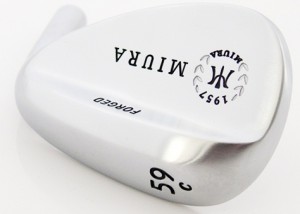One of my weekend golf buddies, a former college player, shared one of his short game secrets with me last year. And it didn’t have anything to do with technique, like ball position or the “hinge and hold” method espoused by Phil Mickelson. No, it simply revolved around the simple fact that he owned two identical sand wedges, one reserved for practice and one reserved for playing only.
You see, my cagey friend didn’t want his “playing” wedge’s spin-imparting grooves to be worn down by his diligent and regular practice sessions. For practice, he used another like-model wedge and he didn’t care how many balls he chipped and pitched with it. Thus when Saturday morning came around and the Nassau bets were at stake, that playing wedge with its sharp and clean grooves was in his bag and results around the green were always impressive.
This story somehow came to mind after I tried out a new forged wedge, the Miura C-Grind Series 1957, this winter while playing in Florida. Although a respected name in Japan, Miura Golf was not a brand with which I was familiar. But I learned it has a rich and deep-rooted history with a compelling story.
Miura Golf was founded by Katsuhiro Miura in historic Himeji City, known in Japan as the ancient home of master steel craftsmen who forged and shaped the iconic samurai swords. From out of this samurai past the area evolved and became the “steel region of Japan.” In 1928, the first golf clubs were produced in Himeji City and so began another legacy of craftsmanship but one borne out on peaceful fairways and greens. Beginning his club-making apprenticeship at age 16, Miura opened his own golf enterprise seven years later in 1957 (hence the Series name.)
More than 50 years later, Katsuhiro Miura is regarded as a master craftsman and one often described by Japanese media as having the “hands of God.” At 69, Katsuhiro still works in his factory, personally forging clubs and passing down his acumen, core values and gifted skills to his two sons, Yoshita and Shinei—both esteemed club-makers.
Known for meticulous quality across its product line, the Miura family devoted special time and research for its C-Grind wedges. In fact, Katsuhiro and his sons made trips to Europe and North America to study an array of diverse playing conditions and turfgrass elements and how they might impact the Miura wedge. Not only did they want to deliver a high performance wedge in keeping with Miura’s lofty quality standards, but they also wanted a versatile club suitable for “a broad range of conditions.” Having played with the wedge extensively in Florida in a variety of course settings, I can attest the C-Grind performs admirably and as promised.
To an avid golfer’s eye, the Miura wedge is thing of beauty. Addressed against the ball, the wedge sits naturally and is exceptionally-defined with its clean, satin chrome finish. The feel of the club is equally appealing. It’s a by-product of Miura’s steadfast reliance on “mild” steel in all of the forged club-making process. The technical aspects of the process baffle me but as noted in product material the “techniques rearrange the molecular structure of the mild steel that is uniform throughout the hitting area of the club.” I don’t know how it’s done but the C-Grind delivers the desired conundrum of both softness and strength. Especially with shots around the green, the ball comes off of the face with just the right speed and feel. The forging and 14-step manufacturing process using mild steel must be prime contributors to this pivotal playability asset.
Out of the sand, the wedge (57 degree) was also a gem, imparting a crisp strike and delivering plenty of spin. But mindful of my golf buddy’s regimen, I limited my sand play with this club in fear of marring it by an errant stone or pebble. Often possessing the “hands of clod,” I wanted to save my face and that of the C-Grind.
In Himeji City, there’s an ancient castle—the largest in Japan—that draws visitors from across the country and around the world. Defended in its day by loyal samurai, the well-preserved castle is officially designated as a “national treasure.” Having now experienced the craftsmanship and beauty of a Miura wedge, I wouldn’t be surprised if one day Katsuhiro is similarly honored.
Oh yes, the sticker price? Given its high quality and hand-crafted limited production, the MSRP for the C-Grind wedge is a reasonable $210. Just don’t waste it on practice balls.
For more information about the complete line of Miura clubs, visit www.miuragolf.com
Note: Be sure to watch the excellent Miura Tradition Room video and especially “the feature presentation.”
Special note: Although Japan is still reeling from the devastating earthquake and tsunami on March 11, Miura Golf in Himeji City– located in the nation’s southern region– was spared any damage or loss of life.

